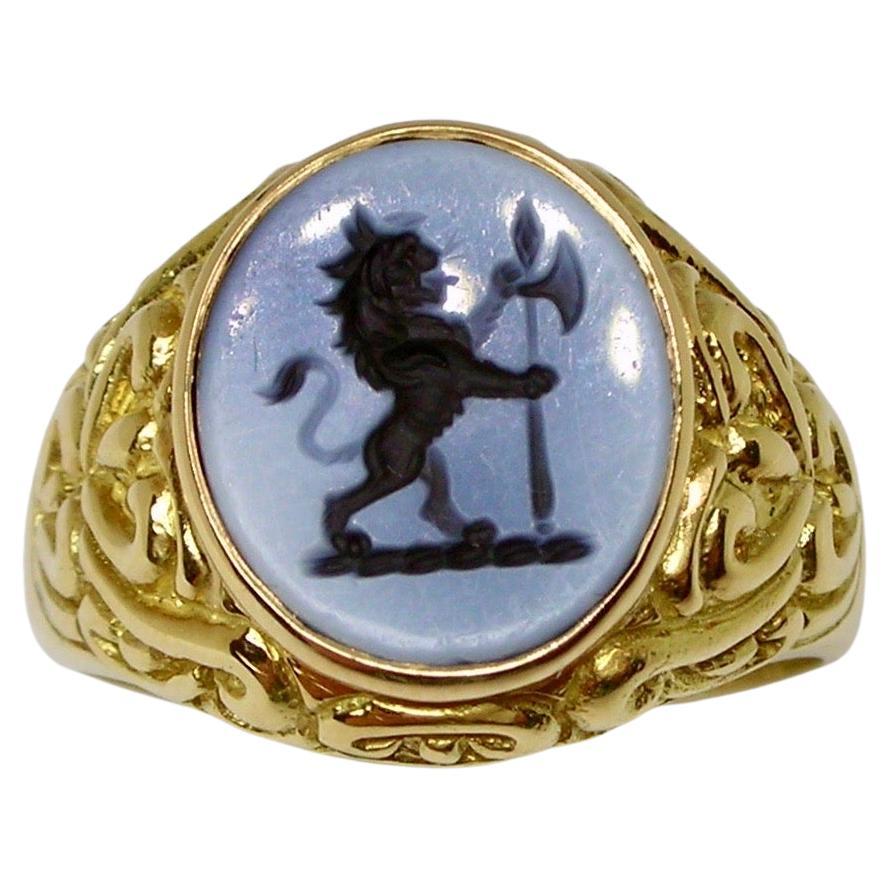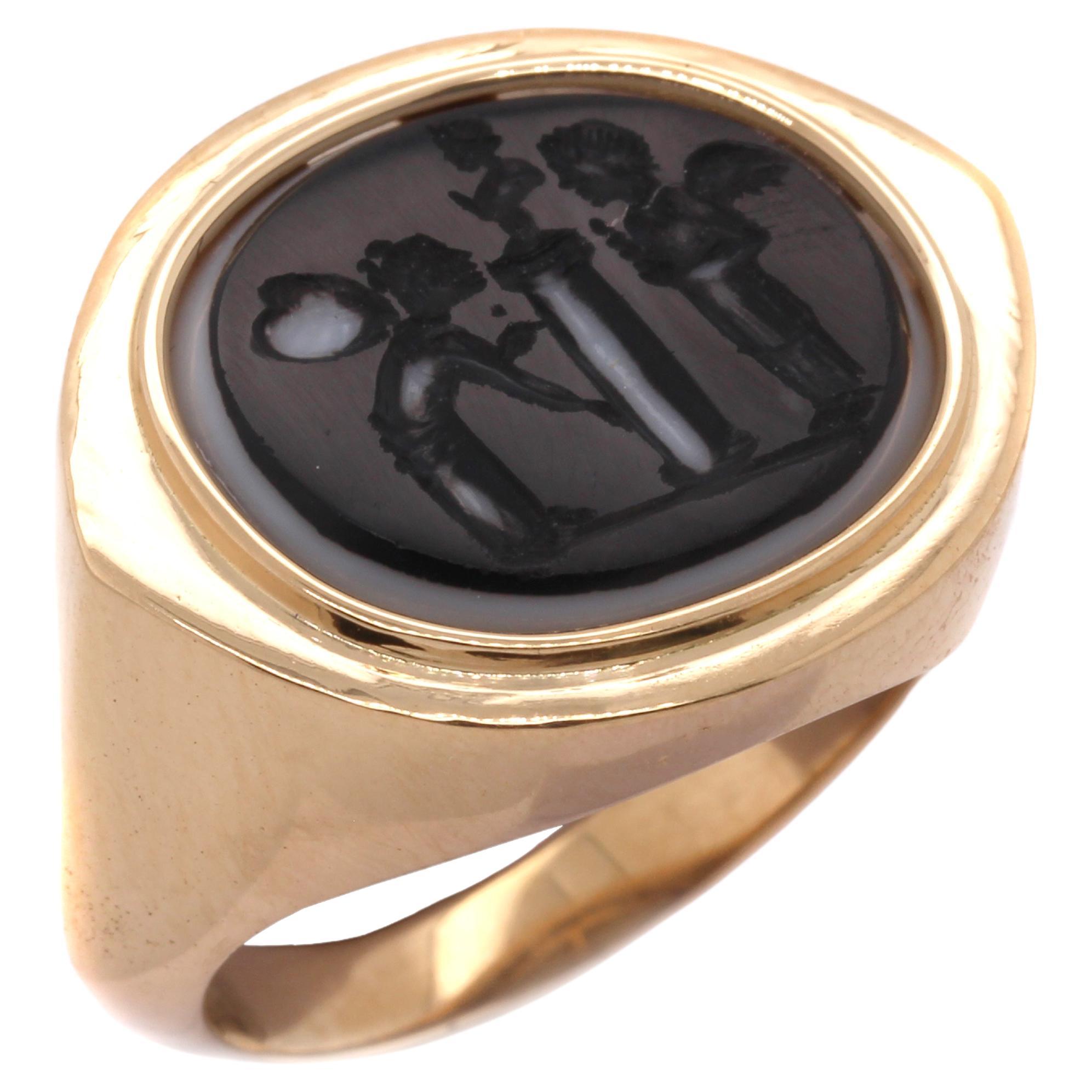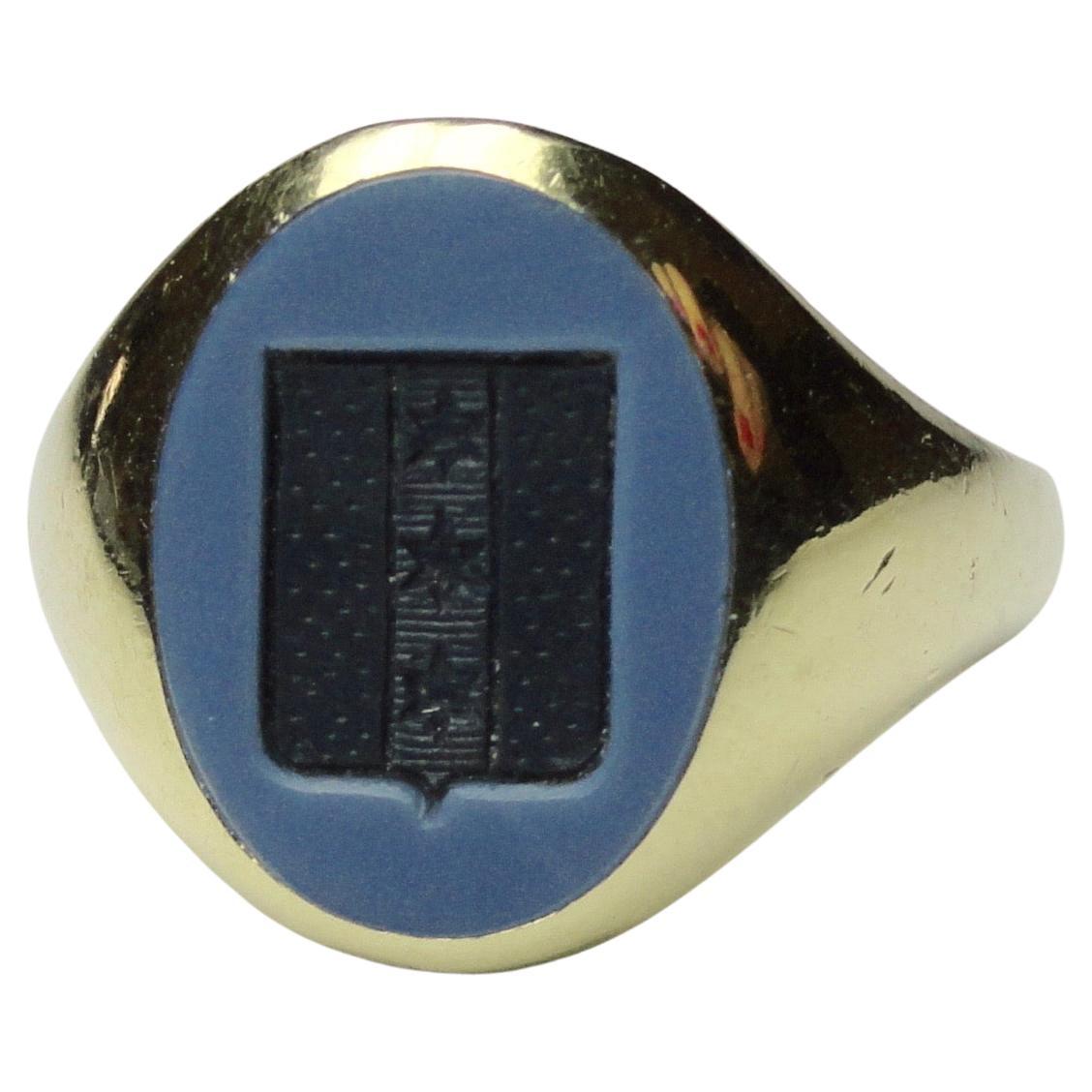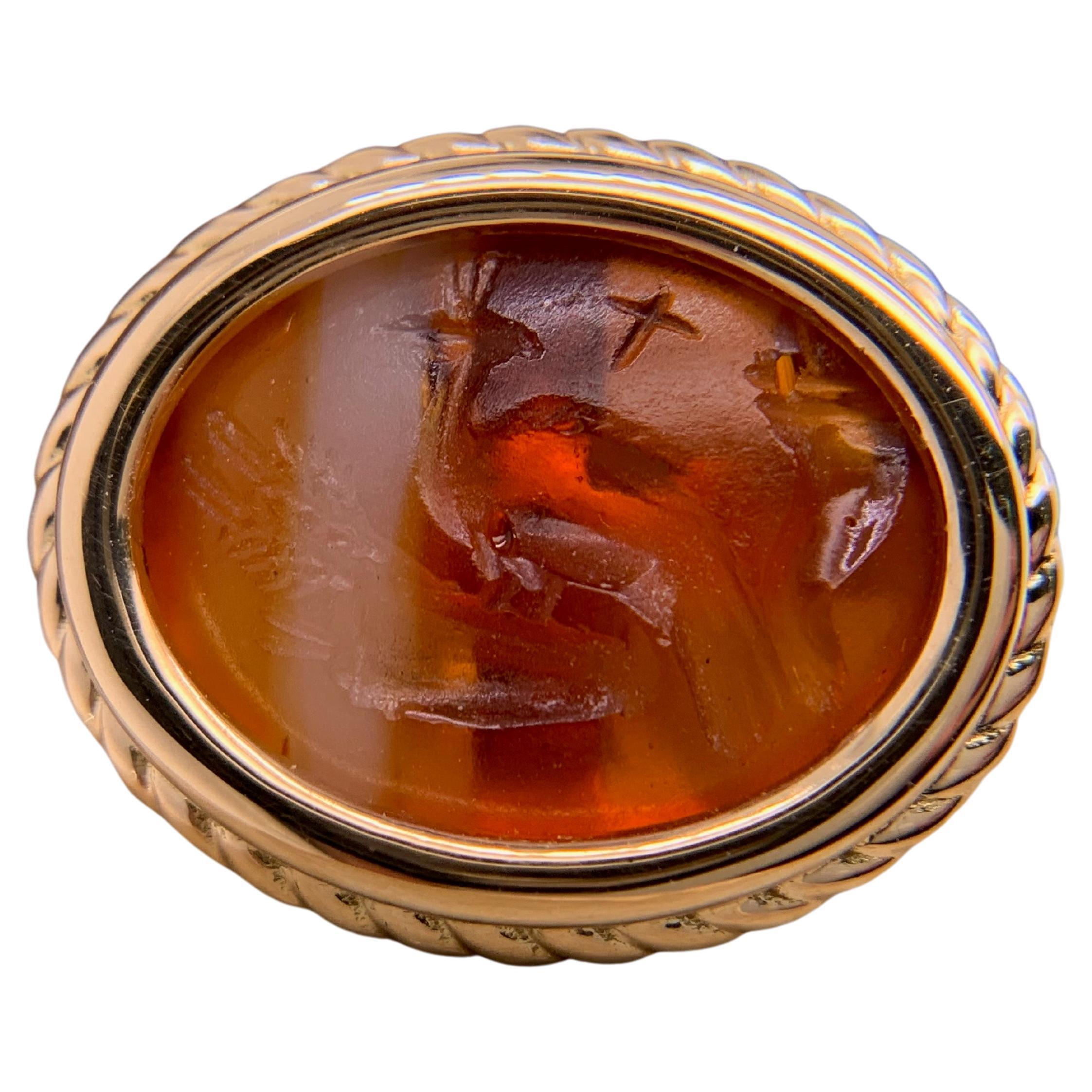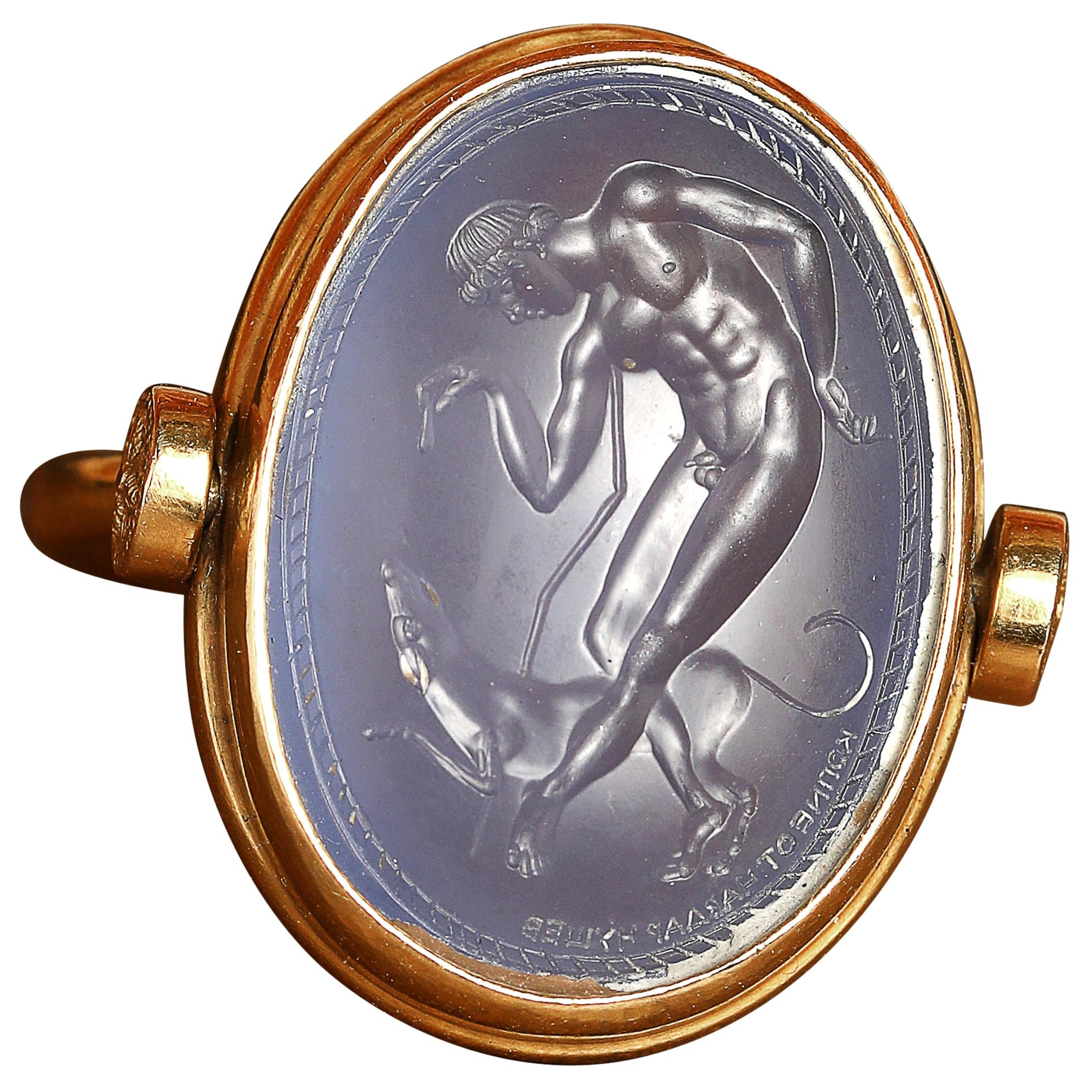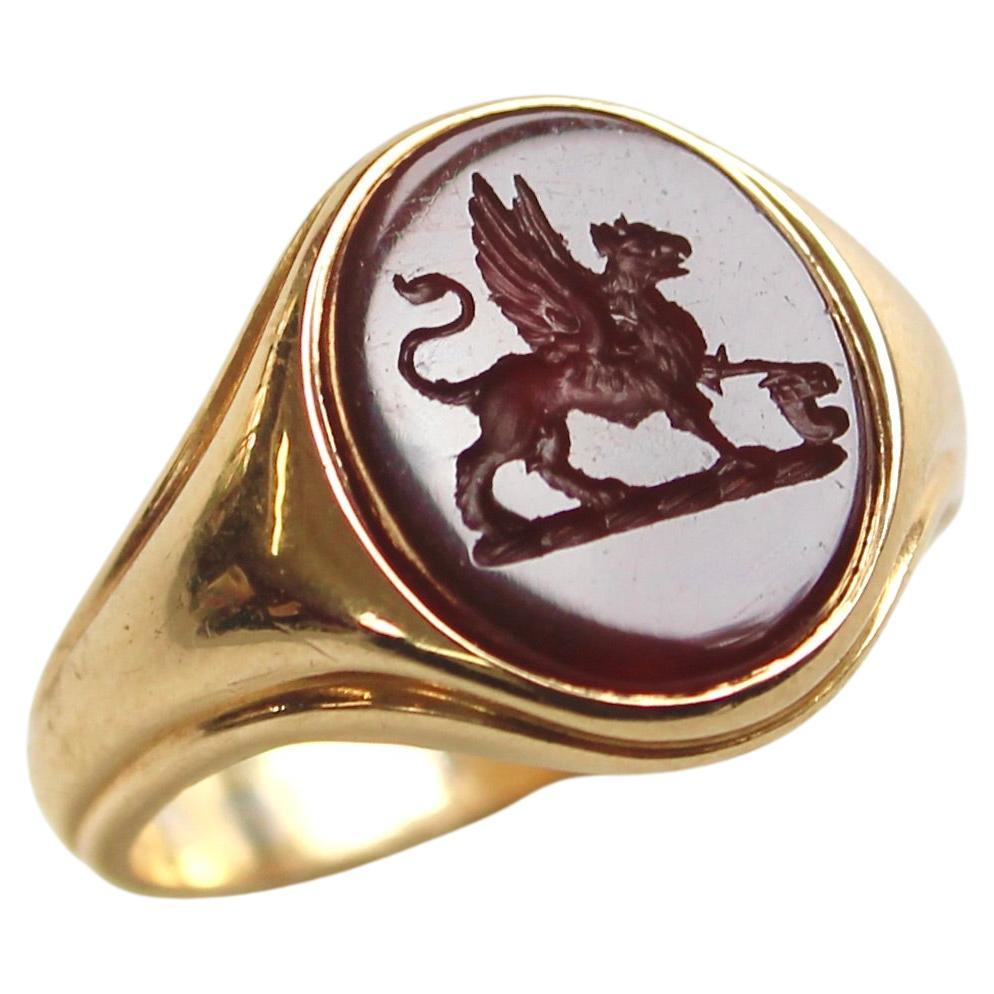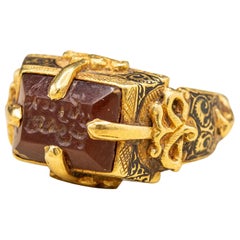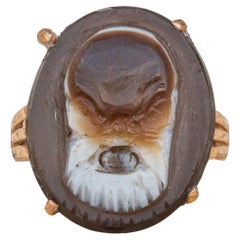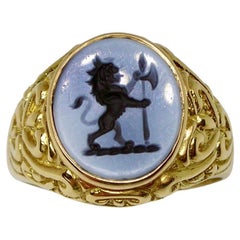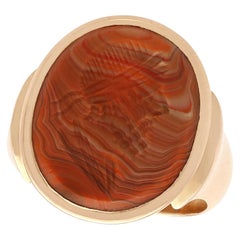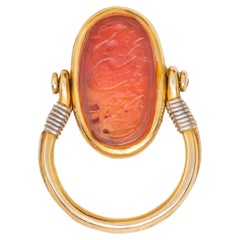
Antique French Gold Swivel Ring with Islamic Orange Agate Calligraphic Intaglio
View Similar Items
Video Loading
Want more images or videos?
Request additional images or videos from the seller
1 of 17
Antique French Gold Swivel Ring with Islamic Orange Agate Calligraphic Intaglio
About the Item
About the Seller
5.0
Vetted Seller
These experienced sellers undergo a comprehensive evaluation by our team of in-house experts.
Established in 2019
1stDibs seller since 2022
32 sales on 1stDibs
Typical response time: 14 hours
More From This SellerView All
- Museum-Grade Antique Early Seljuk ‘Selçuklu’ Period Islamic Intaglio RingLocated in London, GBThis incredible gold ring dates from the 12th century Seljuk dynasty. The carnelian intaglio is set within a typical Seljuk tapered rectangular bezel with a four-pronged gold setting...Category
Antique 15th Century and Earlier Asian Signet Rings
MaterialsCarnelian, 22k Gold
- Scarce 13th-14th Century Islamic Late Seljuk Empire Gold and Eye Agate RingLocated in London, GBA superb Islamic gold and agate ring dating from the 13th to 14th century. The brown ‘sheep’s eye’ agate cabochon sits within a truncated conical bezel with a four-pronged setting soldered to the outside, typical of Seljuk dynasty rings. In the space between the prongs, the bezel is engraved with various zoomorphic motifs. These engravings continue down the tapered, flat shank and each shoulder is decorated with a splayed bird. This animal based ornamentation was most commonly found on Seljuk rings towards the end of the empire (13th-14th century). For similar referenced examples of Seljuk rings see pages 55-69 in ‘Islamic Rings...Category
Antique 15th Century and Earlier Turkish Signet Rings
MaterialsAgate, Gold
- Antique Gold Cameo Ring Greek Theatre Mask Silenus Hardstone Intaglio SignetLocated in London, GBA very unusual antique gold ring set with a carved brown and white hardstone cameo depicting the theatrical comic mask of Silenus, the Greek mythological old rustic god of wine-making and drunkenness. The ring was made in the late 19th century and carries French control marks for 18K gold, whilst the cameo is probably Italian and made slightly earlier, circa 1800. Silenus was a companion to the wine god Dionysus, and suitably he was a notorious consumer of wine, usually drunk and supported by satyrs or carried by a donkey. Silenus was described as the oldest, wisest and most drunken of the followers of Dionysus, and was said to possess special knowledge and the power of prophecy when intoxicated. He presides over the other satyrs and is related to musical creativity, prophetic ecstasy, drunken joy and drunken dances. Silenus was usually depicted as a jovial old man, bald yet bearded, with a pot-belly, thick lips and snub-nose. The masks worn to play him in theatre really emphasised these features, as you can see with this cameo carving Theatre was a key part of ancient Greek culture. The theatrical masks worn by the actors, known as ‘prosopon’, served various purposes. They enabled individual actors to play multiple roles (or genders) in the same performance; the exaggerated expressions helped define the character being portrayed; they helped spectators in the back rows to tell the characters apart. This particular masked as mentioned before is a comedic Silenus, please see final photo for other examples of Silenus masks in museum collections. UK size N 1/2, US size 7 4.84g 18K gold French ‘tête...Category
Antique Early 19th Century Italian Georgian Signet Rings
MaterialsAgate, 18k Gold
- Antique Seljuk ‘Selçuklu’ Period Gold Islamic Medieval Signet Ring 11th-13th CLocated in London, GBThis quite small (yet mighty) 21K gold ring dates to the 11-13th century Seljuk dynasty. The hexagonal bezel features a negative cursive inscription within a border containing arabes...Category
Antique 15th Century and Earlier Signet Rings
MaterialsGold
- Important Antique Finnish 18K Coat of Arms Klinckowström Intaglio Signet RingLocated in London, GBA superb, scarce Finnish antique 18K gold ring that was made in Helsinki in the year 1854. The oval carnelian coat of arms intaglio is set in a large intricate gold repoussé work mount featuring scrolled foliate motifs. Incredibly, thanks to a full set of Finnish hallmarks, as well as from the intaglio carving itself, we can identify who commissioned and wore this superb seal ring. The coat of arms engraved into the carnelian gemstone is that of the Klinckowström family, an old Prussian noble house whose members played prominent roles in the history of Prussia, Sweden, Finland and Austria. The family was granted nobility in Sweden in 1684 by King Charles XI, and then received the rank of baron in 1759 from King Adolf Frederick. The baronial branch was listed in the Finnish House of Nobility (Ritarihuone) from 1818 until the family line ended in Finland in 1883. This baronial element can also be seen in the engraved coat of arms from the specific type of coronet used, it is set with pearls and known as a ‘Friherrlig rangkrona’, the coronet for Baron. The hallmarks tell us that this ring was made in Helsinki in the year 1854. Accordingly, the ring must have been made for a Baron (male) of the Klinckowström family, present and active in Finland during the mid-19th century. After researching into the genealogial records, only one member of the family settled in Finland, which was Baron Otto Wilhelm Klinkowström (1778-1850), and this ring would have been commissioned by his son Baron Arthur Wilhelm Wilhelmsson Klinckowström, shortly after his father’s passing. The ring would have been made in used to seal deeds and important letters in wax regarding family affairs. Arthur had two sons. Emil and Alexander who carried on the baronial title until 1883, when the family line ended on the male side. Although the time period of this ring also matches up with his both his sons, according to heraldry records they both carried a slightly different coat of arms. Arthur, the owner of this ring enrolled in the House of Knights in Finland aged 17 and soon after received the Order of St. John of Jerusalem. He spent the remainder of his years in various senior military positions, such as Lieutenant Colonel of the Finnish Sharpshooter Battalion and Colonel of the Kremenchugska Hunter Regiment. He passed away in 1860, not long after his father, which may explain why this ring is in such excellent condition with minimal signs of usage. His father, Baron Otto Wilhelm Klinkowström (1778-1850) was a Swedish lieutenant general who later moved to Finland, where he immediately found favour with Czar Alexander I of Russia...Category
Antique 1850s Finnish Victorian Signet Rings
Materials18k Gold
- French Neo-Renaissance Intaglio Signet Ring Manner of Wièse & Froment-MeuriceLocated in London, GBA fantastic French 19th century Neorenaissance silver intaglio ring, in the manner of Jules Wièse and Froment-Meurice, circa 1840. The milky blue ...Category
Antique Mid-19th Century French Belle Époque Signet Rings
MaterialsChalcedony, Silver
You May Also Like
- Antique Agate Intaglio Ring Depicting LionLocated in Milano, MIIntaglio ring in 18ct gold with bicolour agate finely engraved with armed lion, of English provenance, beginning of the XX Century.Category
Antique Early 1900s British Signet Rings
MaterialsAgate, 18k Gold, Yellow Gold
- Antique Banded Agate and Yellow Gold Intaglio RingLocated in Jesmond, Newcastle Upon TyneAn exceptional, impressive antique banded agate and 14 karat yellow gold intaglio signet ring; part of our diverse antique jewelry and estate jewelry collections. This exceptional, fine and impressive signet ring has been crafted in 14k yellow gold. The substantial antique ring setting (circa 1880) displays an oval carved banded agate panel (circa 1820), ornamented with a carved intaglio. The intaglio bears a male profile, featuring a beard and tied headband. The surrounding setting is plain and unembellished, melding with the incurved shaped ring shoulders and blending seamlessly with the plain ring shank. This antique intaglio ring...Category
Antique 1820s Unknown Signet Rings
MaterialsAgate, 14k Gold, Yellow Gold
- Gold Renaissance Ring with Roman Agate Intaglio Depicting a HorseLocated in Chicago, ILRenaissance ring with Roman horse intaglio Ring: Western Europe, c. 1580-90, Roman intaglio: 1st century AD Gold, champlevé enamel, nicolo agate Weight 5.2 gr.; Circumference 57.15 mm.; US size 8; UK size Q In the Renaissance period, ancient cameos and intaglios were highly sought-after collectors’ items. Wealthy owners had them incorporated into signet rings, and in this case, an exceptional and rare ring with sophisticated enameling. The Roman intaglio reflects the spirit of Humanism during the Renaissance, when there was a revived interest in Classical literature and the arts. The horse motif was most likely the personal choice of the wearer or giver of this ring who would have been familiar with its meaning in Classical Antiquity as a symbol of wealth and power. In Ancient Greece images of horses denoted aristocratic status, were symbolic of heroism and the all-important cavalry. A grazing horse as seen here may have represented a favored racehorse. Description: Gold ring with D-section hoop widening towards the oval bezel, plain on the interior and on the exterior the shoulder is decorated in gold against black enamel with symmetrical foliate and floral motifs. The frieze-like decoration continues along the sides of the facetted bezel with dots, dashes and scrollwork, a triangular form with acanthus foliage and fine gold framing line along the base of the bezel with raised mount and fluted collet for a nicolo-agate intaglio. Carved into the bluish grey on brown surface is a grazing horse seen in profile, head bent low. On the underside of the bezel is an elaborate cross motif with scrolls in black enamel against gold. Minor loss of enamel in some areas, through age and wear. The ring is in good wearable condition. Literature: Similar elaborately enameled signet rings set with ancient intaglios or Imperial laureate heads can be found in the British Museum, London (Dalton 1912, no. 308); Tarnóczy Collection; Hanns-Ulrich Haedeke Collection. The highly embellished enameling along the hoop and bezel of this exceptional and rare ring is reminiscent of the ornamental prints...Category
Antique 16th Century European Renaissance Signet Rings
MaterialsAgate, Gold, Enamel
- Castellani Ancient Roman Agate Intaglio Gold RingBy CastellaniLocated in New York, NYCastellani® has selected this Ancient Roman Agate Intaglio for the "Cleopatra" Ring Setting. The intaglio dates to the 3rd to 7th Century. The intaglio is both black and white agate, which is a hard stone and very good for carving. The agate has two layers of color, black on the top and white at the bottom. The agate intaglio is solid and is one piece. The carver was able to use these two color layers to give dimension and detail. The Column and Angel on the left wings are white and the balance is all black. The Carver knew the material he/she was carving and used this to create this very unique scene. The intaglio shows two angels standing on either side of a column/pillar looking at the bust of a man on top of the pillar. The angels are female and male. The bust on the pedestal is of a male. The intaglio is set below the frame. The frame flairs out to a subtle point on the sides and has a flat surface. The "Cleopatra" ring design was a style that Castellani created in the 1860's and was inspired by Ancient Roman rings...Category
21st Century and Contemporary American Etruscan Revival Signet Rings
MaterialsAgate, 18k Gold, Gold
- Victorian 14k Gold Banded Agate Intaglio Signet Ring with ShieldLocated in Venice, CASet in 14k gold, the banded agate intaglio ring is hand-carved with a unique image: a shield topped by a knight’s helmet and a plume of feathers. T...Category
Antique 1880s European Victorian Signet Rings
MaterialsAgate, 14k Gold, Yellow Gold
- Intaglio Agate Ring Medium Size 18 Carat GoldLocated in Milano, MIParticular intaglio ring in bicolour agate and set in 14ct gold. Probably of American provenance and from the beginning of the 1900's.Category
Antique Early 1900s Unknown Signet Rings
MaterialsAgate, Gold, 18k Gold, Yellow Gold
Recently Viewed
View AllMore Ways To Browse
French Antiques Uk
Ancient Egyptian Antiques
Antique Ring 18th Century
1920 Ring Oval
Orange Bezel Set
Antique Egyptian Revival
Antique Jewelry Egypt
Antique Egyptian Jewellery
Early 20th Century Egyptian Revival
18k Gold Egyptian Revival
Egyptian Revival 18k Gold
Antique Etruscan Revival Jewelry
Antique Etruscan Revival
Dated Antique Ring
18th Century Oval
Egyptian Circa 18th Century
Intaglio Carnelian Ring
Arabic Ring
